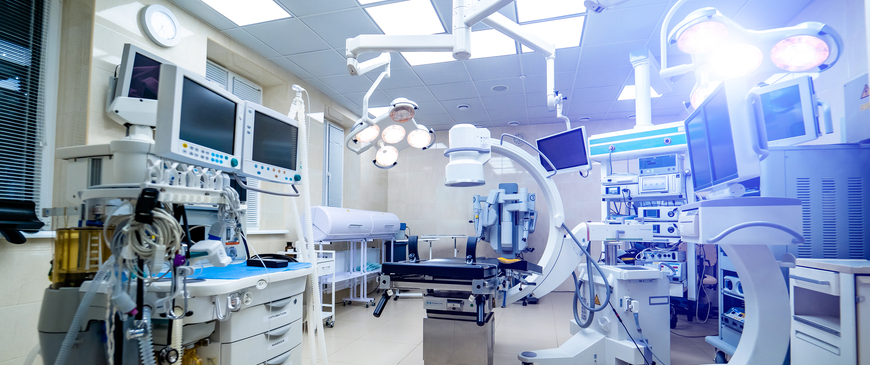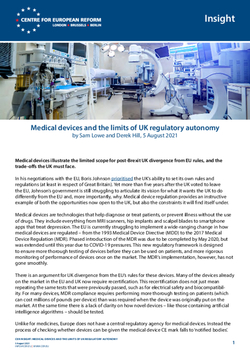
Medical devices and the limits of UK regulatory autonomy
Medical devices illustrate the limited scope for post-Brexit UK divergence from EU rules, and the trade-offs the UK must face.
In his negotiations with the EU, Boris Johnson prioritised the UK’s ability to set its own rules and regulations (at least in respect of Great Britain). Yet more than five years after the UK voted to leave the EU, Johnson’s government is still struggling to articulate its vision for what it wants the UK to do differently from the EU and, more importantly, why. Medical device regulation provides an instructive example of both the opportunities now open to the UK, but also the constraints it will find itself under.
Medical devices are technologies that help diagnose or treat patients, or prevent illness without the use of drugs. They include everything from MRI scanners, hip implants and scalpel blades to smartphone apps that treat depression. The EU is currently struggling to implement a wide-ranging change in how medical devices are regulated – from the 1993 Medical Device Directive (MDD) to the 2017 Medical Device Regulation (MDR). Phased introduction of the MDR was due to be completed by May 2020, but was extended until this year due to COVID-19 pressures. This new regulatory framework is designed to ensure more thorough testing of devices before they can be used on patients, and more rigorous monitoring of performance of devices once on the market. The MDR’s implementation, however, has not gone smoothly.
Many of the medical devices already on the market in the EU and UK now require recertification.
There is an argument for UK divergence from the EU’s rules for these devices. Many of the devices already on the market in the EU and UK now require recertification. This recertification does not just mean repeating the same tests that were previously passed, such as for electrical safety and biocompatibility. For many devices, MDR compliance requires performing more thorough testing on patients (which can cost millions of pounds per device) than was required when the device was originally put on the market. At the same time there is a lack of clarity on how novel devices – like those containing artificial intelligence algorithms – should be tested.
Unlike for medicines, Europe does not have a central regulatory agency for medical devices. Instead the process of checking whether devices can be given the medical device CE mark falls to ‘notified bodies’. These are public or private organisations that an EU member-state (and the UK) authorises to approve products before they are put on the market. The best known in the UK is the British Standards Institution (BSI). The notified bodies are struggling to equip themselves with the necessary skills and capacity to cope with the workload arising from the new MDR. Manufacturers are now incurring higher costs and longer timelines to have devices certified or recertified. This is not just because they need to repeat testing, but also because the notified bodies can now take over a year to review the associated technical documentation, when it used to take a few months.
The higher costs and longer timelines create two significant problems. Firstly, some medical devices will be taken off the European market because their manufacturers (often small and medium-sized companies) have decided recertification is not worth it. Secondly, many novel devices developed by European companies are being introduced in the US first rather than in Europe – because the United States Food and Drug Administration (FDA) provides greater clarity and better ways of getting feedback about necessary testing than European regulators. For example, if a manufacturer is developing a novel digital device to help diagnose or treat patients, they can request a meeting with the FDA before they start testing on patients to ensure that the tests they plan address regulatory concerns about the safety and effectiveness of the device. This dramatically reduces the chance that expensive and time-consuming testing will be performed but then found inadequate when the results are submitted for regulatory review. European medical device experts are increasingly talking about a crisis in medical devices that could prevent European patients from accessing medical technologies that are available across the Atlantic.
Many manufacturers have suggested they will not bother with the additional cost and complexity of putting their devices through the UKCA processes on top of the updated European process.
The UK is in a particularly challenging position as a result of Brexit. Had the MDR been implemented as planned in 2020, the UK would have adopted the new European regulations before the end of the Brexit transition period. But because MDR implementation was delayed due to COVID-19, the UK has maintained the old MDD until a new domestic regulatory framework is put in place. As an interim position, the UK is allowing medical devices tagged with the EU’s CE mark to be used until June 2023. After that, all medical devices sold in the UK will need to have been reviewed by UK approved bodies and given a UK Conformity Assessed marking (UKCA). There is not currently any mutual recognition of the necessary medical device testing (conformity assessments) between the EU and UK, so manufacturers selling on both markets will need to go through the testing process twice. Many manufacturers have suggested they will not bother with the additional cost and complexity of putting their devices through the UKCA processes on top of the updated European process: the UK market is simply not large enough for many non-British companies to make the effort worthwhile.
It is therefore possible that UK patients will suffer the fallout of two changes to the medical device regulatory framework in quick succession. This could lead to both a loss of access to some medical technologies that are currently available, and the slow introduction of innovative new technologies. But these challenges also create a window of opportunity for the UK to alter its approach to medical device regulation.
The UK has four potential options. It could:
- Continue with a unique UK regulatory framework for medical devices, requiring the recertification of all medical devices by June 2023. This is the approach which sits most comfortably with the UK government’s desire for regulatory autonomy. But there is a risk that the UK market will be considered too small for some manufacturers to justify the costs, especially if such recertification requires a different type of testing because regulations are different in the UK from elsewhere. Where they do bother, additional certification costs might also be passed on to UK purchasers.
- Pursue option one, but attempt to supplement it with strengthened and new mutual recognition agreements with some other regulatory jurisdictions (Canada, Australia, New Zealand and Singapore are sometimes mentioned). This approach would be more global in nature and could potentially reduce the compliance burden for medical device companies. But it would place some constraints on the UK’s regulatory autonomy, as it would probably require some harmonisation of approach. It would also probably be slow to implement, and require renegotiation when the UK or another country updates its own regulations: it is hard to imagine deep mutual recognition agreements with multiple jurisdictions in place in time for the current 2023 deadline.
- Continue to allow EU CE marked medical devices to be marketed in the UK for a much longer period of time and de-prioritise the implementation of its own regime. The UK could try to negotiate access to the new European database on medical devices (EUDAMED) to assist in this, or require manufactures to use a similar UK database. This approach would offer greatest continuity for businesses, and ensure ongoing alignment between Great Britain and Northern Ireland (where Northern Ireland’s special status under the Northern Ireland protocol means CE marking still applies). But it would also see the UK inherit the challenges arising from messy MDR implementation in the EU, without the means to influence EU attempts to address them.
- Open up its market by unilaterally allowing medical devices that are in use in other trusted jurisdictions such as the US, EU, Canada and Australia to be sold in the UK, subject to a registration requirement. This approach is arguably most appealing from a patient’s point of view. It would allow UK patients to access innovative medical devices that are already on the market in other countries – most importantly, those available in the USA. This might even be labelled an “Australian-style” medical device regulation, as it could be designed to copy the approach of the Australian medical regulator, the Therapeutic Goods Administration (TGA). The TGA allows a fast-track approval process for medical devices that have undergone overseas assessments or approvals, with obligations on manufacturers to monitor and take responsibility for any safety issues. But there is a downside: the UK should not expect reciprocity from these foreign regulators – especially the USA. This would give foreign manufacturers an advantage over UK ones: for example a US company would have easy access to the UK market but UK companies would not enjoy similar easy access to the US market. In addition, unilateral recognition of foreign certification would mean other countries determined the rules used to ensure medical devices are safe and effective, leaving the UK as a rule taker – and not just from the EU.
Of course, the divide between the different options is not clear cut in practice. An amalgamation of aspects of the four approaches listed is possible – for example the unilateral recognition of the testing regimes of other countries does not preclude the negotiation of subsequent mutual recognition agreements. And the unilateral recognition of foreign certification does not prevent the UK from attempting to carve out a regulatory niche for itself. For example, leveraging the NHS, the UK could seek to provide an innovation-friendly framework for new medical devices, such as AI powered medical devices and drug-device combinations such as surgical implants that slowly release a drug. (Although companies producing these innovative products would still have one eye on eventual US and EU authorisations.) But the issues associated with a new UK approach to regulating medical devices illustrate the trade-offs the UK will need to navigate.
With its relatively small market size, the UK will struggle to break free entirely from the regulatory pull of larger economies – particularly when it comes to highly regulated products.
Opportunities to diverge from EU rules and approaches, and deliver better outcomes for companies, consumers and patients do exist. However, with its relatively small market size, the UK will struggle to break free entirely from the regulatory pull of larger economies – particularly when it comes to highly regulated products. In the case of medical devices, British patients are more likely to benefit if the UK systematically embraces its position as an Australian-style rule taker, and free-rides on the regulatory innovation and capacity of others. UK companies might also benefit from such an approach, as their device development could be focused on the requirements of large export markets (perhaps especially the US) in the knowledge that doing so would also ensure access to their home market.
Sam Lowe is a senior research fellow at the Centre for European Reform and Derek Hill is a professor of medical imaging science at University College London.


Comments
That means an “Australian” conformity assessment scheme is not possible. It will be either CE or CE/UKCA, and there is too much political and economical pressure for UKCA to go away.
Add new comment